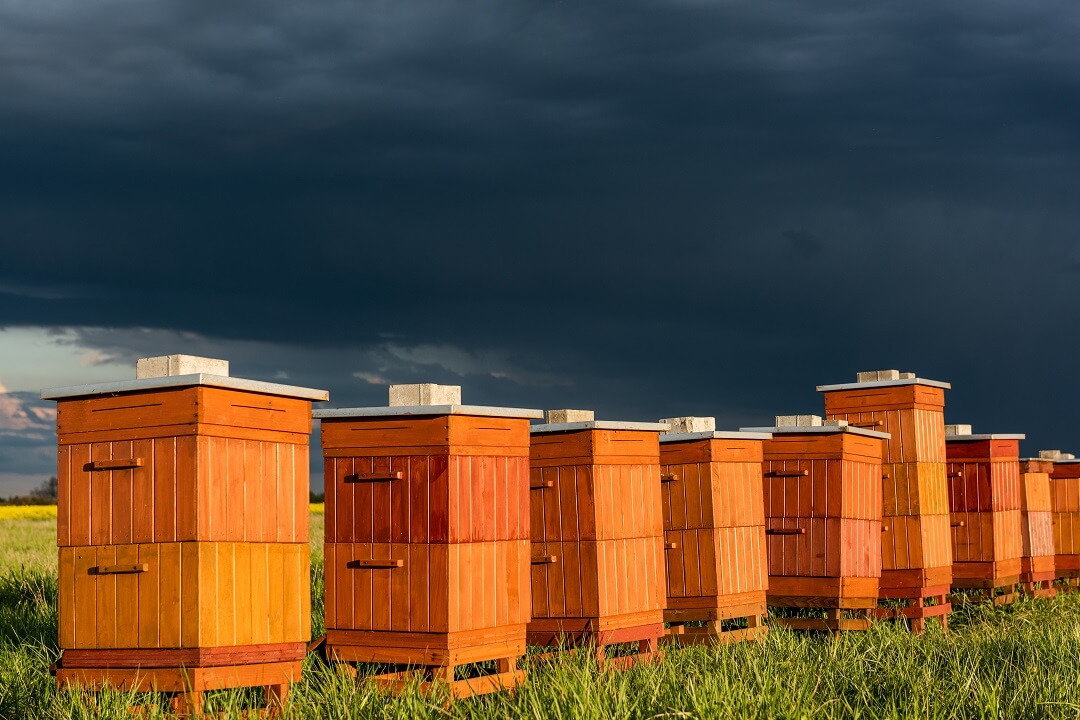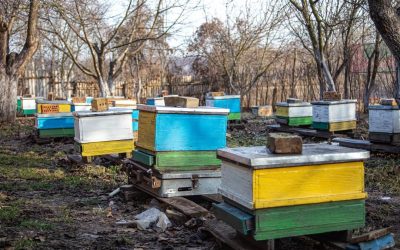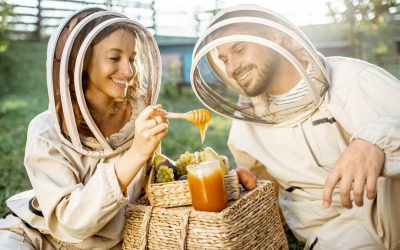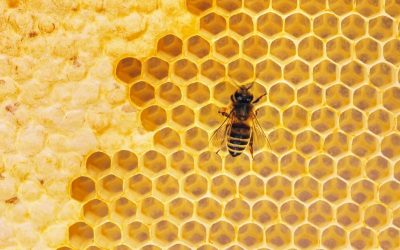Ready to join the buzz and start your own beehive? Or maybe you already have a hive but want to up your beekeeping game. Either way, these 10 essential tips for successful beehive management are here to help.
Beekeeping can be a fun and rewarding hobby, but it’s important to have a solid understanding of how to care for your bees and manage your hive. From choosing the perfect location and hive type, to understanding the life cycle of bees, to protecting your hive from pesky pests and diseases, these tips will set you up for sweet success.
So don your beekeeping gear, grab your hive tool, and dive into these 10 essential tips for successful beehive management. With a little knowledge and care, you’ll be well on your way to becoming a confident and successful beekeeper. Let’s get buzzing!
Key Takeaways
-
- Choose the right location and hive type to suit your bees’ needs.
- Understand the life cycle of bees and the role of the queen, drones, and workers.
- Regularly inspect your hive to monitor the health and productivity of your bees.
- Keep your hive clean by removing debris and dead bees and ensuring adequate ventilation.
- Feed your bees if necessary, especially during the winter or during a dearth.
Tip #1: Find the Perfect Location for Your Hive
Where you set up your hive can have a big impact on the health and happiness of your bees. When it comes to choosing a location, there are a few key things to keep in mind:
Sunshine is a Must
Bees absolutely adore the sun and need plenty of it to stay warm and active. Aim for at least six hours of direct sunlight per day to keep your bees buzzing with energy.
Wind Can be a Bee’s Worst Enemy
While bees are amazing fliers, they can struggle in strong gusts. To keep your bees from getting blown away, choose a location that is protected from strong winds. This could be the lee side of a building or a hedgerow, for example.
Proximity to Nectar and Pollen Sources is Key
Bees rely on nectar and pollen from flowers to survive and produce honey, so choose a location that is close to a variety of flowering plants, like fruit trees, vegetables, herbs, and wildflowers.
Make Sure Your Hive is Easily Accessible
Last but not least, make sure your hive is easily accessible and convenient for you to check on and work with. After all, regular inspections and hive maintenance are crucial for the health and productivity of your bees.
By taking the time to carefully consider the location of your hive, you can help ensure the success of your bees and maximize their productivity. Happy hunting, and don’t forget to bring your beekeeping gear!
Read More: Beehive Placement: 10 Tips to Find the Best Location for Your Bees
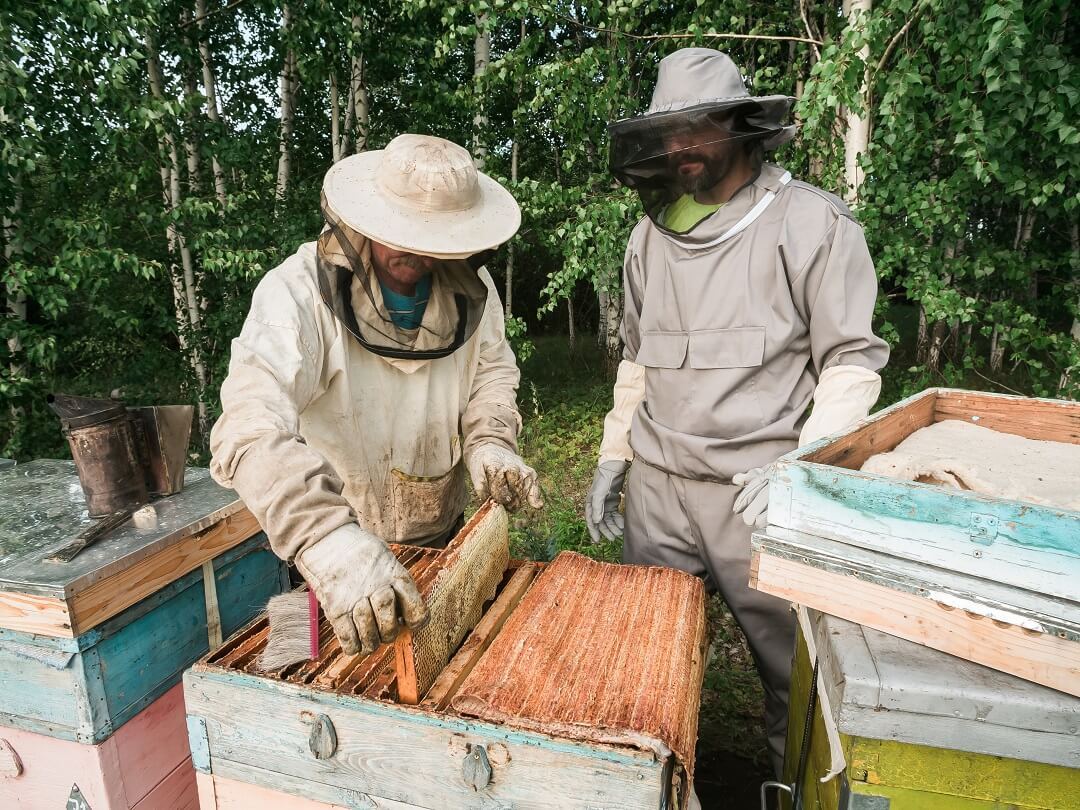
Tip #2: Invest in the Right Equipment
Beekeeping requires a variety of specialized tools and equipment to help you manage your hive and protect yourself from stings. While there are many different options out there, some basic items are a must-have for any beekeeper.
Hive Box
This is where the bees live and raise their young. There are several different types of hive boxes to choose from, including Langstroth, top bar, and Warre hives. Each has its own benefits and drawbacks, so it’s important to research and choose the one that best fits your needs and goals.
Frames
These hold the beeswax foundation, which serves as a base for the bees to build their comb. There are several different sizes and styles of frames available, and the type you use will depend on the type of hive you have.
Foundation
This is a sheet of wax with a pattern of hexagonal cells imprinted on it. The bees use this as a template to build their comb, which they use to store pollen, nectar, and eggs. You can purchase a pre-made foundation or make your own.
Protective Gear
When working with bees, it’s important to protect yourself from stings. This includes a beekeeping suit or veil, gloves, and a hat. You may also want to invest in a smoker, which is a tool used to calm the bees and make it easier to work with them.
By using the proper equipment and taking the time to learn how to use it correctly, you can help ensure the safety and productivity of your bees.
Read more: Beginner Beekeeping Supplies Guide: Your Official Checklist
Tip #3: Understand the life cycle of bees
To be a successful beekeeper, it’s important to understand the life cycle of bees and how they contribute to the hive. By knowing what to expect at each stage, you can better identify problems and take appropriate action to support the health and productivity of your bees.
It All Begins with an Egg
The life of a bee starts as a tiny white egg, about the size of a grain of rice. The queen bee is responsible for laying the eggs, and she can lay up to 2,000 per day! She determines the sex of each egg based on the type of cell it is laid in.
Next Comes the Larva Stage
After about three days, the eggs hatch into larvae. The worker bees feed the larvae a special substance called royal jelly to help them grow and develop. After about six days, the larvae spin a cocoon and enter the pupal stage.
Pupa Time!
During the pupal stage, the bee’s body undergoes major changes as it transforms into an adult. This process takes about 12 days for a worker bee and 16 days for a drone (male bee).
Hello, Adult Bee!
Once the pupal stage is complete, the bee emerges as an adult. Worker bees have a ton of responsibilities, including foraging for nectar and pollen, building and repairing the hive, and tending to the young. Drones, on the other hand, don’t have any responsibilities within the hive and are solely focused on reproducing.
By understanding the different stages of a bee’s life, you can better understand the needs and behaviors of your hive and take appropriate action to support the health and productivity of your bees.
Tip #4: Regularly inspect your hive
Regularly inspecting your hive is a crucial part of beehive management. It helps you keep an eye on the health and productivity of your bees and identify any potential problems.
How Often Should I Inspect?
The frequency of your inspections will depend on a few factors, including the type of hive you have, the time of year, and the weather. As a general rule, aim to inspect your hive at least once a month. During the spring and summer, when the bees are most active and the hive is likely to grow quickly, you may want to inspect more frequently.
What Should I Look For?
During an inspection, you’ll want to look for signs of pests or diseases, like varroa mites or American foulbrood. You’ll also want to check on the overall health of the hive, including the size of the population and the number of food stores.
How Do I Inspect?
To inspect your hive, you’ll need to suit up in protective gear and use a smoker to calm the bees. Then, carefully open the hive and inspect each frame, looking for signs of health and problems. Be gentle with the frames and avoid squashing any bees.
Keep a Record
It’s a good idea to keep a record of your inspections, including any observations or actions you took. This can help you track the health of your hive over time and identify patterns or trends.
By regularly inspecting your hive, you can help ensure the well-being of your bees and take timely action to address any problems.
Tip #5: Keep Your Hive Sparkling Clean!
Maintaining a clean hive is essential for the health and productivity of your bees. By removing debris and dead bees and ensuring adequate ventilation, you can help prevent overheating and other problems.
Sweep Away Debris and Dead Bees
Bees can leave behind bits of wax, pollen, and other debris as they go about their daily activities. Over time, this can build up and create an unsanitary environment for the bees. To keep your hive clean, it’s important to remove any visible debris and dead bees from the hive. Use a hive tool to gently scrape away any excess wax or debris and dispose of it safely.
Make Sure Your Hive is Well-Ventilated
Bees generate heat as they move about the hive, and it’s important to provide adequate ventilation to prevent overheating. Too much heat can stress out the bees and even kill them. To ensure proper ventilation, make sure your hive has at least one entrance, and consider adding additional vents or screened bottom boards.
Keep Your Equipment Clean
In addition to keeping the inside of the hive clean, it’s also important to regularly check and clean your beekeeping equipment. This includes your protective gear, hive tools, and any other items you use when working with the bees. By keeping your equipment clean, you can help prevent the spread of pests and diseases and ensure a safe and healthy environment for your bees.
By taking the time to keep your hive and equipment clean, you can help ensure the health and productivity of your bees.
Tip #6: Keep Your Bees Well-Fed
While bees are generally able to find enough food from natural sources, there may be times when they need a little extra help. By providing supplementary food, you can help ensure the health and productivity of your bees.
When Should I Feed My Bees?
There are several situations when you may need to feed your bees:
- During the winter: Bees rely on stores of honey and pollen to survive the cold months. If your hive doesn’t have enough food to last the winter, you may need to provide supplementary food.
- During a dearth: A dearth is a period of time when there are few or no flowers blooming and, therefore few or no sources of nectar and pollen. If your bees are experiencing a dearth, you may need to provide supplementary food to help them through.
- After a swarm: If your hive has swarmed, the remaining bees may not have enough stores of honey and pollen to sustain them. In this case, you may need to provide supplementary food to help them rebuild their population.
What Should I Feed My Bees?
There are several options for supplementary food, including sugar water and pollen supplements. Sugar water is made by mixing granulated sugar with water in a ratio of about 1:1. Pollen supplements are made from dried pollen and can be purchased or made at home.
How Do I Feed My Bees?
To feed your bees, you’ll need to use a feeder. There are several types of feeders available, including internal and external feeders. Internal feeders are placed inside the hive, while external feeders are placed outside the hive. Whichever type you use, be sure to follow the manufacturer’s instructions and take care not to spill the food or make a mess.
By feeding your bees when necessary, you can help ensure their health and productivity and give them the support they need to thrive. Don’t let your bees go hungry – make sure they have the fuel they need to keep buzzing!
Tip #7: Know how to handle swarms
Swarms can be a natural part of the hive’s reproductive cycle, but they can also be a sign of stress or overcrowding. Knowing how to prevent and manage swarms is an important part of beehive management.
Preventing Swarms
There are several steps you can take to prevent swarms:
- Keep your hive healthy: A healthy hive is less likely to swarm. Make sure your bees have enough food, space, and ventilation to thrive.
- Monitor the hive: Keep an eye on the size and activity of your hive, and be on the lookout for signs of swarming, such as an increase in the number of queen cells or a sudden drop in the population.
- Split the hive: If your hive is getting too crowded, you can split it into two hives to give the bees more space. This can help prevent swarms and can also increase your overall honey production.
Handling Swarms
If your hive does swarm, there are several steps you can take to capture and relocate the bees:
- Wear protective gear: When handling a swarm, it’s important to protect yourself from stings. Wear a beekeeping suit or veil, gloves, and a hat.
- Locate the queen: The queen is the key to the swarm, as the rest of the bees will follow her. Look for a group of bees clustered around a single bee, as this is likely the queen.
- Capture the swarm: There are several methods you can use to capture a swarm, including using a swarm box or a bee bag. Follow the manufacturer’s instructions or seek guidance from an experienced beekeeper.
- Relocate the bees: Once you have captured the swarm, you will need to relocate it to a new hive. Make sure the hive is set up and ready for the bees before you release them.
By understanding how to prevent and handle swarms, you can help keep your hive healthy and productive.
Tip #8: Protect your hive from pests and diseases
There are many pests and diseases that can harm bees, and it’s important to be vigilant and take steps to prevent infestations.
Some common pests and diseases to watch out for include:
- Varroa mites: Varroa mites are tiny parasites that feed on the blood of bees. They can weaken the bees and make them more susceptible to other diseases.
- American foulbrood: American foulbrood is a bacterial disease that affects the larval stage of bees. It can kill young bees and weaken the hive.
- Small hive beetles: Small hive beetles are a type of pest that can infest bee hives and feed on the bees’ honey and pollen stores.
- Nosema: Nosema is a fungal disease that affects the digestive system of bees. It can cause diarrhea and weaken the hive.
To protect your hive from pests and diseases, there are several steps you can take:
- Use protective gear: When working with bees, it’s important to protect yourself from pests and diseases. Wear a beekeeping suit or veil and gloves, and disinfect your equipment after each use.
- Monitor for pests and diseases: Regularly inspect your hive for signs of pests and diseases. Look for symptoms such as abnormal behavior, unusual comb patterns, or dead bees.
- Treat as needed: If you do find pests or diseases in your hive, there are several treatment options available. These may include chemical treatments.
Tip #9: Harvest honey responsibly
Harvesting honey is one of the most rewarding aspects of beekeeping, but it’s important to do it responsibly. By following best practices, you can help ensure the health and well-being of your bees and maximize your yield.
When to Harvest
The best time to harvest honey will depend on a variety of factors, including the type of bees you have and the climate you live in. As a general rule, it’s best to harvest honey when the bees have finished their main nectar flow, which is typically in the late summer or early fall. At this point, the bees will have plenty of stores of honey to sustain them through the winter.
How to Harvest
To harvest honey, you will need to remove the honeycomb from the hive and extract the honey. Here are the basic steps:
- Suit up in protective gear.
- Use a smoker to calm the bees.
Remove the honeycomb from the hive, being careful not to crush the bees. - Cut or scrape off the wax cappings from the honeycomb using a hive tool or capping knife.
- Place the honeycomb in a honey extractor, which is a machine that spins the honeycomb to separate the honey from the comb.
- Collect the honey as it is extracted.
- Filter the honey to remove any bits of wax or debris.
- Store the honey in clean, airtight containers.
Leave Enough Honey for the Bees
Bees need honey to survive the winter, so it’s important to leave enough in the hive for them to eat. As a general rule, aim to leave about 60 pounds (27 kilograms) of honey per hive. This will help ensure that your bees have enough food to last through the cold season and get a strong start in the spring. Remember, it’s not just about the honey – it’s about supporting the health and well-being of your bees, too!
Read more: Maximizing Honey Yield: How to Get Bees to Make More Honey
Tip #10: Join a beekeeping community
Starting and managing a beehive can be a rewarding and educational experience, but it can also be challenging at times. One of the best ways to get support and guidance is to join a beekeeping club or seek out an experienced beekeeper.
Benefits of Joining a Beekeeping Club
There are many benefits to joining a beekeeping club, including:
- Learning from others: Beekeeping clubs are a great way to learn from other beekeepers and share knowledge and experiences. You can ask questions, get advice, and learn about different techniques and approaches.
- Meeting other beekeepers: Beekeeping clubs provide an opportunity to meet and network with other people who are interested in bees. You can learn from their experiences and form supportive relationships.
- Accessing resources: Many beekeeping clubs have resources such as books, articles, and videos that can help you learn more about bees and beekeeping. You may also have access to equipment or supplies through the club.
Get Expert Help from a Seasoned Beekeeping Pro!
“Get a buzz” on beekeeping by seeking out an experienced mentor! An experienced beekeeper can be a valuable resource, providing helpful tips and tricks to help you navigate the ins and outs of managing a hive. From troubleshooting issues to offering guidance on techniques, an experienced beekeeper can be a valuable ally on your journey as a new beekeeper. Plus, their support and encouragement can give you the confidence to “bee” the best beekeeper you can be!
There are several ways you can find an experienced beekeeper to work with:
- Ask around: You may know someone who keeps bees or who knows someone who does. Ask for recommendations or introductions.
- Join a beekeeping club: Many clubs have members who have been keeping bees for a long time and are happy to share their knowledge and experience.
- Look online: There are many online forums and communities where beekeepers share knowledge and experiences. You can join these groups and ask for recommendations or guidance.
By seeking guidance from an experienced beekeeper, you can get the support and guidance you need to become a successful and confident beekeeper.
Conclusion
Beehive management is an important and rewarding aspect of beekeeping. By following these 10 essential tips, you can help ensure the health and productivity of your bees and maximize your yield.
With a little knowledge and care, you can help support the health and well-being of your bees and contribute to the health of the environment.

